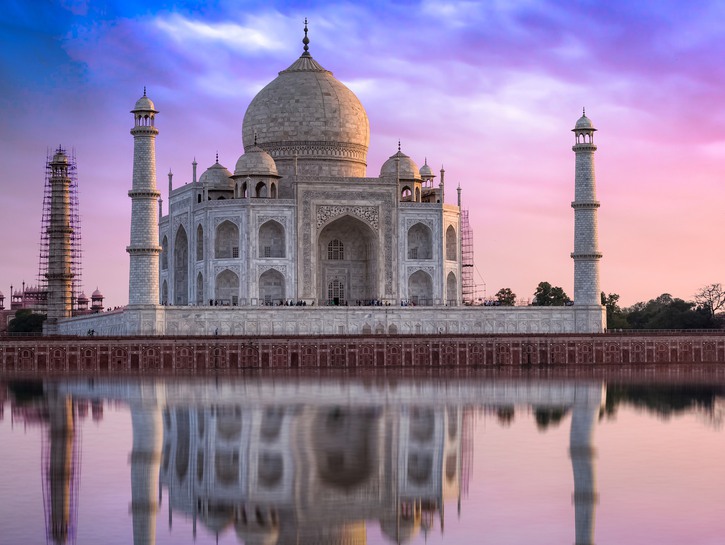
It’s instantly recognizable as India’s crown jewel: the Taj Mahal. Located just outside the city of Agra, this jaw-droppingly magnificent monument has enchanted onlookers for hundreds of years. But there’s more to this legendary site than meets the eye. Here are ten fascinating facts about this iconic place, where amazing architecture and art intertwine with a melancholic love story that’s lasted the ages.
Videos by TravelAwaits
1. It Was Built For The Favorite
The Taj Mahal was commissioned in 1632 by Shan Jahan, a Mughal emperor. He was heartbroken after his favorite wife, Mumtaz Mahal, died giving birth to their 14th child. Jahan wanted to construct a mausoleum to her memory that would stand for centuries as a symbol of his love. He had a grand vision, and spared no expense in executing on it.
2. It Took An Army Of Architects
Shah Jahan was said to be quite hands-on with the building’s plans, hiring more than thirty designers and architects who made his grand vision a reality. One of them, Ismail Khan, hailed from Persia and had worked throughout Turkey for the Ottoman Empire.
Compare images of the Taj and some of Istanbul’s most famous mosques. You’ll see the striking resemblance in their domes and overall structure.

3. It Features Glittering Gemstones
If you’re lucky enough to travel to the Taj, you’ll be blown away by the intricate marble carvings and gemstones decorating both the building’s facade and its inner chamber.
In all, 40 different kinds of gemstones were used, including carnelian, lapis, malachite, and jade. The inlay work, which includes massive garlands of gemstone flowers pieced seamlessly into the marble, is an absolute marvel. One can only imagine the tedious, detailed work put in by the craftsmen who carved and fitted these stones in Mumtaz Mahal’s memory.
4. Visitors Should Consider The Calligraphy
Since the Taj Mahal is a mausoleum and Shan Jahan was Muslim, its construction adheres to stict religious standards. You won’t see a single image of a person here. That’s because according to tradition, thought — and art– should be centered on Allah. What you will see plenty of is gorgeous, meticulously crafted calligraphy adorning the entrance and sides of the building.
The calligraphy, made mostly of black marble set into the Taj’s white base face, is made up of various verses — or surahs — from the Quran. A master craftsman who worked on the site left a humble message in script near the base of the interior dome: “Written by the insignificant being, Amanat Khan Shiraz.i”
5. It Took Lots of Time, Money, And Elephants To Build
Building the Taj Mahal — everything from drawing up plans and hauling tons of marble, to cutting and fitting gemstone and calligraphy inlays — was obviously a massive undertaking. It took nearly 22 years to complete. Shah Jahan had 22,000 laborers on the job and a total of 1,000 elephants were used to haul raw materials to the site. As you can imagine, this symbol of enduring love did not come cheap. Calculated in modern rates, the legendary building and surrounding gardens would cost about $827 million to construct.
6. There’s Legend Of A Black Taj Mahal
As it turns out, the Taj Mahal might not have been all that Jahan had planned. While he intended to entomb his beloved Mumtaz inside the grand white marble dome, according to legend, the Shah wanted a separate dome constructed for himself, located just across the Yamuna River. It was to be crafted from black marble, a mirror opposite facing his wife’s tomb.

When you step inside the Taj Mahal, this theory seems to play out: Mumtaz’s cenotaph is in the middle of the dome, while Jahan’s is off to the side, as if it’s an afterthought. (Another interesting fact: These gorgeous sarcophagi are actually empty. The bodies of the Shan and Mumtaz are buried directly below, at the garden level.) While archeologists have largely dismissed the idea of a black Taj Mahal, the story persists.
7. Shah Jahan Never Visited His Masterpiece
For all of the time Shah Jahan spent bringing the gorgeous Taj Mahal to life, he never got to mourn his wife in the palace he built for her. In 1657, one of his sons overthrew him, seized his power, and placed him under house arrest in Agra Fort, near the Taj.
After Jahan died in captivity in 1666, his body was buried beside Mumtaz’s, in the grand place he’d spent half his life building in her memory.
8. Mumtaz Isn’t The Only Royal Lady Honored At This Site
The Taj Mahal is a place dedicated to love lost, a universal storyline that took a royal twist in 1992. That’s when Princess Diana took a solo trip to the Taj, during a time when rumors about her marriage were swirling.
She was captured in an instantly recognizable photo, looking forlorn on a bench in front of the Taj Mahal. The bench has since been named in her honor. During a recent trip, Prince William and Princess Kate posed for their own, happier portrait there.
9. The Monument Hides During War And Strife
At night, and especially when the moon is full, the Taj Mahal glows a spun silvery color and can be seen from miles away. While it’s incredibly beautiful, this also means it’s vulnerable to air attacks during times of war.
To protect the pride of its country, India has resorted to camouflaging the Taj’s grand dome in the past. During World War II, more recent battles with neighboring Pakistan, and even after the 9/11 attacks, the beautiful dome has been covered with black cloth and even bamboo to help keep it out of sight. The efforts have worked: The Taj hasn’t been harmed during times of unrest.

10. It Receives Regular Spa Treatments
To protect its gorgeous, creamy complexion from air pollution, the Taj Mahal gets regular spa-like treatments! Mudpacks are routinely applied to the surface of the dome and four surrounding minarets to remove staining and discoloration from air pollution. The Indian government is also doing its part: It’s shut down nearby factories, and India’s Supreme Court recently ordered officials to consult experts throughout the world to develop ways to keep the Taj beautiful for centuries to come.
Photo Credit: Roop Dey / Shutterstock
